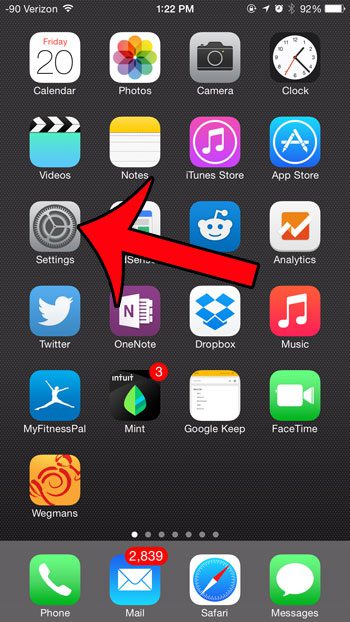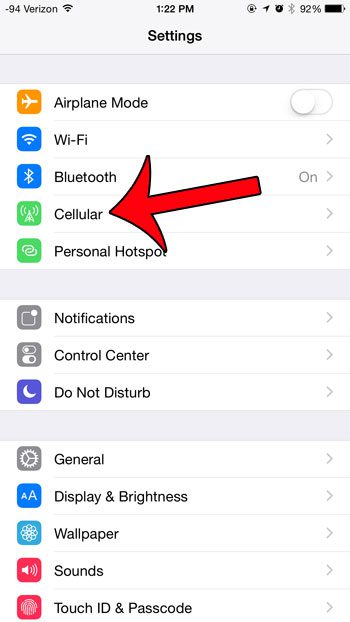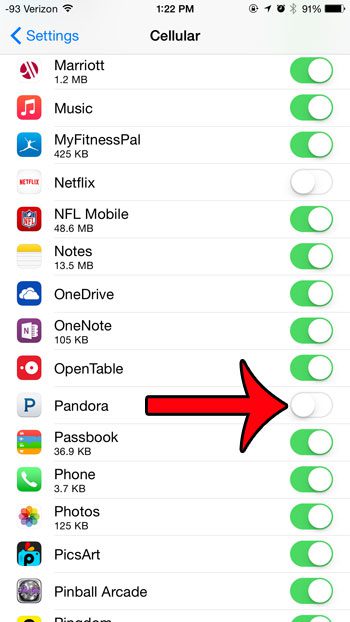Certain apps on your iPhone can use a lot of data, especially when their main purpose is to stream media.
This means that apps like Netflix, Hulu, and Pandora can use a lot of cellular data if you let them work on cellular networks.
Our tutorial below will show you how to stop Pandroa from using your iPhone’s cellular data so that you don’t use so much of it when you listen to your music.
How to Disable Pandora on Cellular on an iPhone
- Open Settings.
- Select Cellular.
- Turn off the Pandora option.
Our guide continues below with more information on changing Pandora’s data settings, including pictures of these steps.
Related: You can read about how to turn off Pandora if the app keeps playing in the background when you close it.
Unlimited cellular data plans are becoming less and less common, and the limited amount of data that you can use on your mobile phone is rather expensive.
You chip away at that monthly data allotment each time that an app downloads data from the Internet when you are connected to your cellular network.
Some apps only need to download a small amount of data, so they will have a minimal impact on your data allotment, but other apps need to constantly download data in order to function properly.
The most data-intensive apps are those that stream media, such as video and music.
Video streaming services like Netflix use much more data than music streaming services like Pandora, but it can still add up over time.
So if you find that Pandora is the cause of any issues with your cellular data usage, then you may decide to block Pandora from using your cellular data. Our guide below will show you how.
How to Restrict the Pandora iPhone App to Wi-Fi
The steps in this tutorial were written using an iPhone 6 Plus, in iOS 8. These steps may vary for earlier versions of iOS. You can read this article to find out which version of iOS you are using on your iPhone.
Are you looking for a good, affordable Bluetooth speaker to use with your iPhone? This Oontz Angle is one of the best options there is.
Step 1: Touch the Settings icon on your Home screen.

Step 2: Select the Cellular option near the top of the screen.

Step 3: Scroll down and find the Pandora option, then tap the button to the right of it to turn off cellular data for the app.
You will know that it is turned off when there is not any green shading around the button, such as in the image below.

Now that you know how to stop the Pandora app on your iPhone from using cellular data, you can preserve that data for other apps that might need it more.
Do you have too many stations on your Pandora account, and you need to start trimming down the list? This article will show you how to delete stations from your Pandora account directly through the iPhone app.
More Information About Pandora
Pandora is a music streaming service that has an app for the iPhone. It was started in 2000 and has since grown to become one of the world’s most popular music streaming services. Users of the Pandora app for iPhone can listen to music on demand and build bespoke radio stations based on their favorite songs and artists.
The app includes a big music library with millions of tracks from all genres and performers. The library is continually being replenished with new music, guaranteeing that customers have access to the most recent and greatest recordings. The app also includes personalized recommendations based on the user’s listening history. This helps consumers to find new songs that they might not have discovered otherwise.
The option to build bespoke radio stations is one of the app’s standout features. This is accomplished by picking a favorite song or performer, and the app will construct a station based on comparable songs. The user can then fine-tune the station by adding or removing artists, songs, or genres. Users can use this feature to build a radio station that is personalized to their specific music likes.
The app also has a simple and user-friendly layout that makes it simple to explore and find the music you want to listen to. Users can also bookmark their favorite stations and music for offline listening. This is especially handy for those who are on the go or have restricted data connectivity.
Pandora Plus is a premium version of the program that is available in addition to the basic version. This version includes extra capabilities such as limitless skips, the option to replay songs, and the ability to listen to music when not connected to the internet. Pandora Plus is ad-free, so users will not hear interruptions while listening to music.
The Music Genome Project is another element that distinguishes Pandora from other music streaming services. This is a complex algorithm that analyzes each song and categorizes it based on genre, tempo, and instrumentation. This enables the app to deliver highly tailored suggestions to users, guaranteeing that they are continually listening to music that they enjoy.
Despite its numerous capabilities, the Pandora app has certain limits. One of the most common complaints about the app is that it only allows users to listen to music on one device at a time. This means that customers cannot listen to music on numerous devices at the same time. Another issue is that the app can be slow to launch, especially when there are a lot of tracks or playlists to load.
Finally, the Pandora music streaming app for iPhone is an excellent method to listen to music on demand and discover new artists. Its massive song library, personalized suggestions, and capacity to create bespoke radio stations set it apart in the congested music streaming industry. However, due to constraints such as poor load times and a lack of simultaneous multi-device support, it may not be the best choice for everyone.

Matthew Burleigh has been writing tech tutorials since 2008. His writing has appeared on dozens of different websites and been read over 50 million times.
After receiving his Bachelor’s and Master’s degrees in Computer Science he spent several years working in IT management for small businesses. However, he now works full time writing content online and creating websites.
His main writing topics include iPhones, Microsoft Office, Google Apps, Android, and Photoshop, but he has also written about many other tech topics as well.